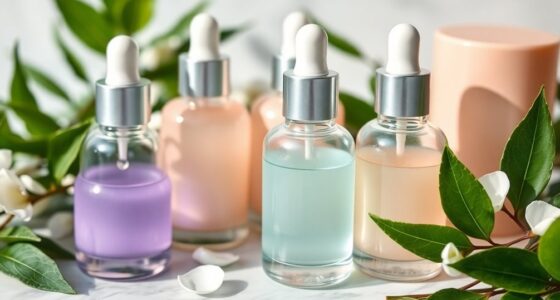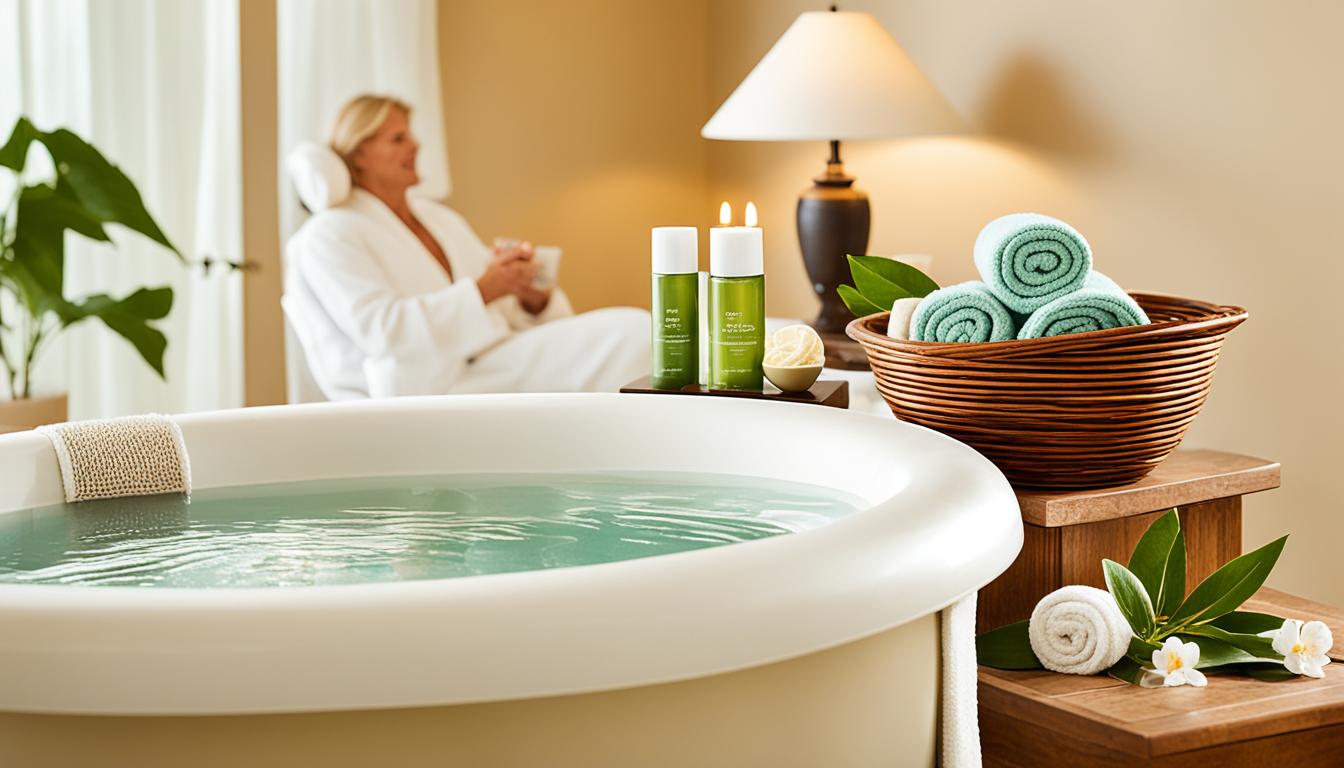To treat hyperpigmentation and achieve an even skin tone, start by using a broad-spectrum sunscreen daily with at least SPF 50. Incorporate potent ingredients like Vitamin C and retinoids into your routine to inhibit melanin production and boost cell turnover. Exfoliating with AHAs a few times a week helps improve skin texture. At home, consider using targeted treatments that contain tyrosinase inhibitors like kojic acid. For faster results, explore professional options like chemical peels or laser treatments tailored to your skin type. Curious about more in-depth strategies and treatments? There's plenty more to uncover!
Key Takeaways
- Daily application of broad-spectrum sunscreen with SPF 50 is crucial to prevent further hyperpigmentation and protect skin from UV damage.
- Incorporate Vitamin C and retinoids into your skincare routine to inhibit melanin production and enhance skin cell turnover.
- Consider professional treatments like chemical peels or laser therapy for quicker, more effective results in reducing dark spots.
- Use exfoliating agents such as AHAs 1-2 times a week to improve skin texture and promote absorption of other products.
- Consult a dermatologist for a tailored treatment plan and to monitor progress for optimal skin health and even tone.
Understanding Hyperpigmentation

Understanding hyperpigmentation starts with recognizing what causes it. This skin concern arises when your skin produces excess melanin, resulting in darker patches. Common forms include sun damage, post-inflammatory hyperpigmentation (PIH), and melasma. If you have dark skin tones, you may notice more pronounced effects from these conditions.
Sun exposure considerably contributes to hyperpigmentation. When your skin is exposed to UV rays, it stimulates increased melanin production, leading to visible dark spots, especially on areas frequently exposed to sunlight.
Hormonal changes, like those during pregnancy or from birth control, can also trigger melasma, which often worsens with further sun exposure. Additionally, factors such as stress can influence skin health, and anxiety relief through aromatherapy may play a role in managing skin conditions by promoting relaxation and reducing stress-related skin issues.
If you've experienced inflammation or injury, such as acne scars or burns, you might develop post-inflammatory hyperpigmentation. This condition is particularly prevalent in individuals with darker skin types, making it essential to understand your unique skin needs.
Your genetics play a role too, influencing your susceptibility to developing dark spots. By recognizing these factors, you can better understand how hyperpigmentation may affect you, paving the way to address and manage your skin concerns effectively.
Prevention Strategies

To effectively prevent hyperpigmentation, you need to adopt a proactive skincare routine. Start with daily application of broad-spectrum sunscreen with an SPF of 50, even when you're indoors. Regularly reapplying sunscreen, especially after swimming or sweating, is essential to shield your skin from harmful UV rays that can worsen hyperpigmentation. Avoid excessive sun exposure during peak hours (10 AM to 4 PM) to considerably reduce the risk of new pigmentation issues.
Incorporating antioxidants like Vitamin C into your regimen can help inhibit melanin production while providing extra protection against environmental damage. Additionally, implementing a consistent routine that includes exfoliating ingredients like alpha hydroxy acids (AHAs) and retinoids can enhance your skin texture and prevent the formation of dark spots.
Here's a quick reference table for your prevention strategy:
| Strategy | Benefits | Frequency |
|---|---|---|
| Apply sunscreen SPF 50 | Protects against UV rays | Daily |
| Use Vitamin C | Inhibits melanin production | Daily |
| Avoid sun exposure (10 AM-4 PM) | Reduces risk of pigmentation | Whenever possible |
| Exfoliate with AHAs/retinoids | Improves skin texture, prevents spots | 2-3 times a week |
Daily Skincare Essentials
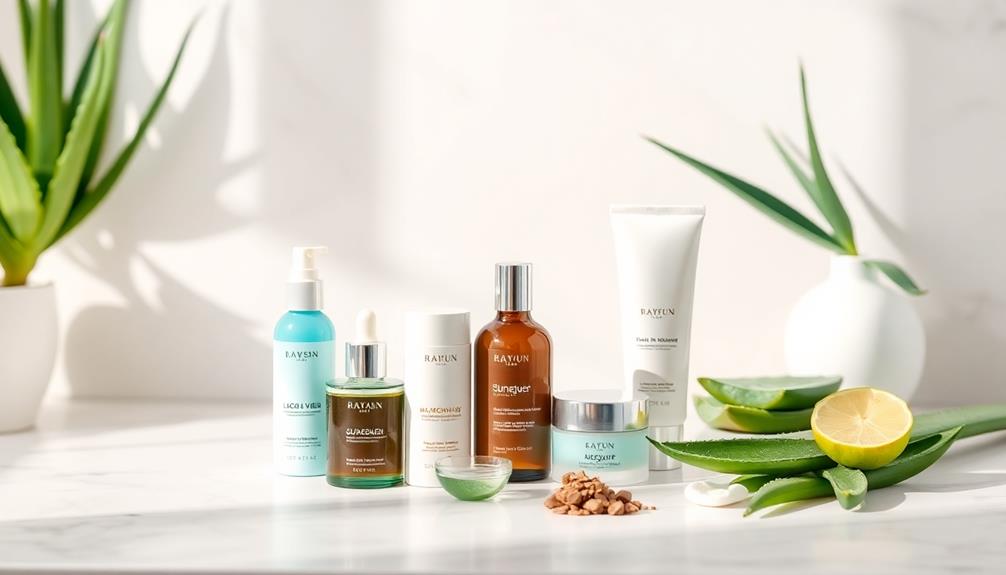
When it comes to managing hyperpigmentation, your daily skincare routine is key.
You'll want to focus on essential ingredients like Vitamin C, retinoids, and AHAs, while also mastering application techniques for maximum effectiveness.
Additionally, incorporating certain herbal teas like chamomile can support your overall skin health and mood stability, potentially enhancing your skincare efforts through mood enhancement.
Essential Ingredients Overview
Incorporating key ingredients into your daily skincare routine can greatly improve hyperpigmentation and uneven skin tone. Start with Vitamin C, a powerful antioxidant that not only brightens your complexion but also protects your skin from UV damage by inhibiting melanin production.
To complement this, consider using acne patches like those made from hydrocolloid material, which can help manage breakouts and prevent scarring while your skin heals.
Next, consider adding retinoids; these vitamin A derivatives boost cell turnover and minimize melanin accumulation, enhancing skin texture and tone over time.
Don't overlook Alpha Hydroxy Acids (AHAs), like glycolic or mandelic acid. These exfoliants help fade dark spots and improve overall skin radiance when used consistently.
You'll also want to include tyrosinase inhibitors such as kojic acid and azelaic acid in your regimen, as they effectively reduce melanin production and are crucial in hyperpigmentation treatments.
To further support your skincare efforts, opt for products like Starface Acne Patches, which are designed for effective blemish treatment.
Application Techniques Tips
Applying skincare products correctly is essential for achieving the best results in your fight against hyperpigmentation.
Start your morning routine with a Vitamin C serum. This powerful ingredient inhibits melanin production and provides antioxidant protection against UV damage, but make sure to layer it under a broad-spectrum sunscreen with at least SPF 50, as protection is vital to prevent further discoloration. Use a nickel-sized amount for your face and reapply every two hours, especially after sweating or swimming.
Consider incorporating inflation-protected annuities for financial stability while investing in your skincare.
At night, incorporate retinoids to promote cell turnover and reduce melanin, starting with lower concentrations to gauge your skin's tolerance. Gradually increase the strength as your skin adjusts.
Don't forget to use exfoliating acids, like glycolic or mandelic acid, 1-2 times a week. These help remove dead skin cells and enhance the penetration of your other treatments.
If you're using lightening creams with ingredients like licorice extract or niacinamide, apply them directly to the affected areas for targeted action.
Always follow up with a moisturizer to keep your skin hydrated. By mastering these application techniques, you'll maximize the effectiveness of your skincare routine and work towards achieving an even skin tone.
At-Home Treatment Options
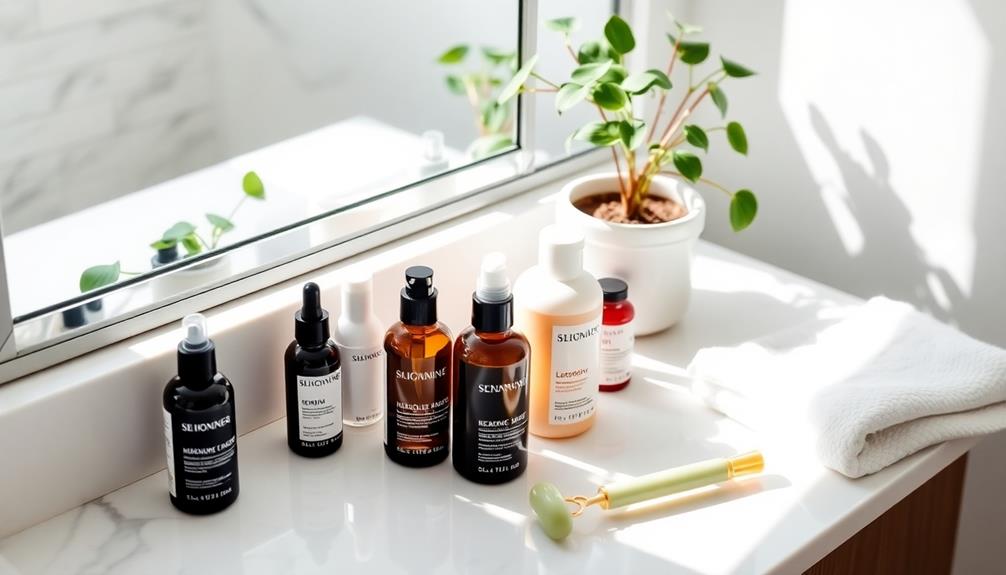
For those looking to tackle hyperpigmentation at home, several effective treatment options can help restore your skin's radiance. Start by incorporating topical agents like vitamin C, retinoids, and alpha hydroxy acids (AHAs) into your routine. These active ingredients work by inhibiting melanin production and promoting skin cell turnover, which is essential for reducing hyperpigmentation.
Additionally, consider trying glycolic acid products known for their exfoliating properties, as they can considerably enhance skin texture and tone.
Regular exfoliation is also key. Gentle exfoliants, such as glycolic or mandelic acid, can improve skin texture and enhance product absorption. Aim to exfoliate 1-2 times a week for best results.
Additionally, consider using botanical extracts like licorice and green tea, which can further support your efforts by soothing the skin and reducing pigmentation.
Another option is utilizing LED masks. Committing to this daily can promote skin rejuvenation and may help lighten hyperpigmented areas over time.
Home peels can also be beneficial, enhancing the penetration of active ingredients. However, exercise caution, particularly if you have darker skin tones, to avoid irritation.
Professional Treatment Overview

When it comes to professional treatments for hyperpigmentation, you've got several effective options like chemical peels, laser therapies, and microneedling.
Each method targets excess melanin and enhances your skin's texture, but choosing the right one is vital.
Additionally, incorporating natural solutions such as herbal alternatives for botox-like effects can complement these treatments by improving skin elasticity and hydration.
That's why seeking expert guidance is essential to tailor the treatment to your specific needs and goals.
Treatment Options Overview
Finding the right treatment for hyperpigmentation can be a game-changer for your skin's appearance and health. You've got several effective treatment options available to tackle this common concern.
Chemical peels are a popular choice, utilizing exfoliating solutions tailored to your specific skin type. It's crucial to recognize that much like the precision needed in coffee brewing techniques, multiple sessions are often necessary for lasting results.
Laser treatments, like Fraxel® DUAL, are also highly effective. They employ microscopic laser columns to target hyperpigmentation while promoting overall skin health. You can expect long-term benefits after a series of sessions.
Another option is microneedling, which creates microchannels in your skin, stimulating collagen and elastin production to improve clarity and address dark spots.
If you're looking for a non-invasive approach, consider Intense Pulsed Light (IPL) therapy. This treatment helps reduce flat pigmentation issues, but it works best for individuals with fair skin types.
Importance of Professional Guidance
Your skin deserves expert care, especially when dealing with hyperpigmentation. Consulting a dermatologist is vital for identifying the specific causes of your condition and developing a tailored treatment plan. Professional treatments, like chemical peels and laser therapies, typically yield quicker results than over-the-counter options, which often require multiple sessions.
| Professional Treatments | Benefits |
|---|---|
| Chemical Peels | Remove dead skin, promote cell turnover |
| Laser Therapy | Targets deeper pigmentation with precision |
| Customized Skincare Products | Higher concentrations tailored to your skin type |
Dermatologists can recommend safe and effective skincare products designed for your unique needs, minimizing the risk of complications. Ongoing follow-up consultations are essential for monitoring progress and adjusting your treatment plan as necessary. With access to advanced technologies, professional guidance enhances the efficacy of your treatments, leading to improved skin tone and texture.
Chemical Peel Benefits

Revealing smoother, more even-toned skin is one of the key benefits of chemical peels. These treatments utilize exfoliating acids, like AHAs and BHAs, to remove the outer layer of skin, encouraging new cell growth. This process considerably improves skin texture and helps reduce hyperpigmentation.
Additionally, incorporating a nourishing routine with products containing butter as a moisturizer can further enhance hydration and skin health.
To achieve the best results, you'll typically undergo a series of sessions, usually ranging from 3 to 6, with each session spaced about a month apart. This gradual approach allows your skin to adapt and heal, maximizing the impact of the treatment.
While you might experience some redness and peeling post-treatment, these effects generally resolve within 5-6 days. Proper aftercare is imperative during this period to guarantee your skin heals well.
One of the most important steps you can take is to regularly apply sunscreen. Protecting your newly exposed skin is essential to prevent further hyperpigmentation and maintain your results.
Laser Treatment Options

How effective are laser treatments for hyperpigmentation? Laser therapy can be a game-changer, targeting hyperpigmentation while promoting skin rejuvenation. Non-ablative lasers, like Intense Pulsed Light (IPL) therapy, are popular for their ability to improve skin texture without the downtime associated with ablative lasers, which remove skin layers but come with increased risks.
Here's a quick comparison to help you understand your options:
| Type of Laser | Key Features |
|---|---|
| Ablative Lasers | Remove skin layers; effective for severe issues; higher side effect risk. |
| Non-Ablative Lasers | Stimulate collagen; suitable for various skin types; minimal downtime. |
Multiple sessions are usually required, with results becoming noticeable after 3-6 treatments. Remember, post-treatment care is vital. Applying sunscreen and avoiding sun exposure are essential to prevent recurrence of pigmentation and support healing. If you're considering laser treatments, consult a professional to find the best option tailored to your skin type and needs.
Microneedling Explained

Microneedling is a popular procedure that creates tiny injuries in your skin to boost collagen and elastin production.
This technique can also enhance the absorption of topical treatments, including essential oils for skin care, which may further aid in reducing hyperpigmentation.
It offers several benefits for treating hyperpigmentation, but it's important to understand the risks and proper aftercare.
Let's explore how the procedure works, its advantages, and what you need to do post-treatment.
Procedure Overview
With 3 to 6 sessions, microneedling offers a powerful approach to treating hyperpigmentation. This procedure uses fine needles to create controlled micro-injuries in your skin, stimulating the production of collagen and elastin. These essential proteins improve your skin texture and help reduce the appearance of dark spots.
Regular skincare practices, such as those outlined in air purifier maintenance, can also support a healthy skin environment by ensuring superior air quality. Typically, a treatment course consists of sessions spaced about three months apart to yield optimal results. After each session, you might notice slight pinkness in your skin, but this usually subsides within a few days.
Microneedling is suitable for all skin types, although there's a small risk of post-inflammatory hyperpigmentation, especially for those with darker skin tones.
To enhance the effects of microneedling, consider combining it with topical serums or growth factors. This combination can further boost skin rejuvenation and improve pigmentation issues.
Benefits and Risks
Understanding the benefits and risks of microneedling can help you make informed decisions about your skincare journey. Microneedling involves using fine needles to create controlled micro-injuries in your skin, stimulating collagen and elastin production. This process can greatly improve skin texture and tone, making it a popular choice for treating hyperpigmentation.
One of the primary benefits is that microneedling is generally safe for all skin types, provided it's performed by a qualified professional. You can expect to see improvements after a few weeks, especially after multiple sessions, usually between three to six.
However, it's important to be aware of potential side effects. Short-term reactions like mild redness and swelling are common and typically resemble a sunburn, subsiding within a few days.
A major risk to take into account is post-inflammatory hyperpigmentation, particularly for individuals with darker skin tones. This can occur if the procedure isn't administered correctly.
That's why seeking professional administration is essential; it minimizes risks and tailors the treatment to your specific skin concerns. Ultimately, weighing these benefits and risks will guide you in making the best choice for your skincare routine.
Aftercare Recommendations
Following a microneedling session, proper aftercare is essential for achieving the best results and minimizing any potential side effects.
Prioritizing your skin's healing will help prevent issues like hyperpigmentation. Here are some key aftercare recommendations:
- Apply broad-spectrum sunscreen with at least SPF 30 to protect your skin from sun exposure.
- Hydrate your skin using a gentle, hydrating serum or moisturizer to soothe and promote healing.
- Avoid harsh products such as retinoids, exfoliants, or anything irritating for at least a week after your treatment.
- Monitor your healing progress and consult with your dermatologist for follow-up appointments.
Monitoring Treatment Progress
Monitoring treatment progress for hyperpigmentation is vital to achieving the desired results. Regular follow-ups with your dermatologist help assess your skin's response to the chosen treatments and make necessary adjustments. Keeping a skincare journal to track product application and changes in skin condition will aid in identifying what works best for you.
Consider using photodocumentation by taking before and after photos to provide visual evidence of your progress. This practice can motivate you and highlight improvements over time. It's also important to continuously monitor for any adverse reactions, as some treatments may lead to post-inflammatory hyperpigmentation, particularly in darker skin tones.
Your personalized treatment plan may need revision based on your individual responses to treatments. Factors such as skin type, severity of pigmentation, and lifestyle can greatly influence outcomes and effectiveness.
Here's a quick reference table to help you track your monitoring process:
| Monitoring Method | Purpose | Frequency |
|---|---|---|
| Dermatologist Visits | Assess treatment effectiveness | Every 4-6 weeks |
| Skincare Journal | Track product effects | Daily |
| Photodocumentation | Visual progress | Every 2-4 weeks |
Lifestyle Adjustments for Skin Health
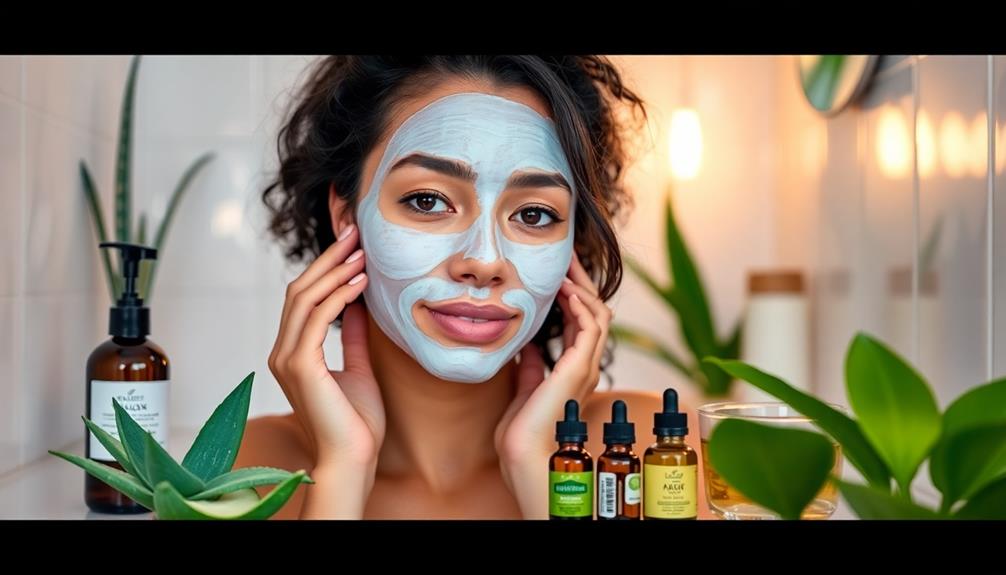
While treating hyperpigmentation, making lifestyle adjustments can greatly enhance your skin health and treatment outcomes. Here are some key changes you can implement:
- Apply broad-spectrum sunscreen every day with SPF 30 or higher.
- Stay hydrated by drinking plenty of water and using moisturizers.
- Incorporate a diet rich in antioxidants like fruits and vegetables.
- Schedule regular skin check-ups with a dermatologist.
Daily application of sunscreen is essential since UV rays considerably contribute to hyperpigmentation.
Staying hydrated helps maintain skin elasticity, reducing the appearance of uneven skin tone.
A balanced diet filled with antioxidants combats oxidative stress, promoting healthier skin overall.
Additionally, avoiding skin-picking behaviors is vital, as they can lead to irritation and scarring, worsening hyperpigmentation.
Frequently Asked Questions
How Do You Treat Hyperpigmentation and Uneven Skin Tone?
To treat hyperpigmentation and uneven skin tone, you should apply sunscreen daily, use products with vitamin C and retinoids, consider chemical peels, and consult a dermatologist for personalized treatment options that suit your skin.
What Is the Best Procedure to Even Out Skin Tone?
To even out your skin tone, you've got to explore options like chemical peels or microneedling. Each treatment works wonders, so find what suits you best and watch your skin transform beautifully.
How Do Dermatologists Get Rid of Hyperpigmentation?
Dermatologists use various methods to tackle hyperpigmentation. They often recommend chemical peels, laser treatments, and microneedling to target the issue effectively. Consistent use of topical retinoids and daily sunscreen is essential for ideal results.
How Can I Even Out My Dark Skin Tone?
You'd think evening out your dark skin tone is impossible, right? Start by using sunscreen daily, incorporating vitamin C, and considering treatments like chemical peels. Your skin's potential is waiting to shine; just take action!
Conclusion
In the journey to even out your skin tone, remember that patience is key; just as a gardener nurtures each seed to bloom, you must allow your skin the time it needs to heal. By following the tips outlined and staying committed to your routine, you'll gradually see improvements in hyperpigmentation. Embrace the process, celebrate small victories, and soon enough, you'll reveal a radiant complexion that reflects your inner beauty. Your skin deserves this care, so start today!



